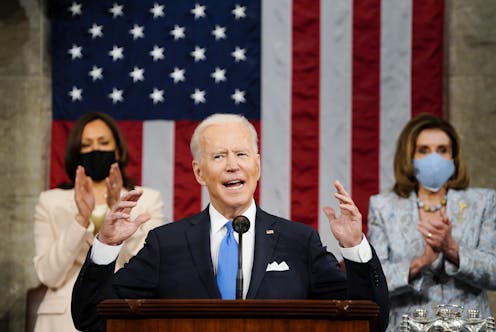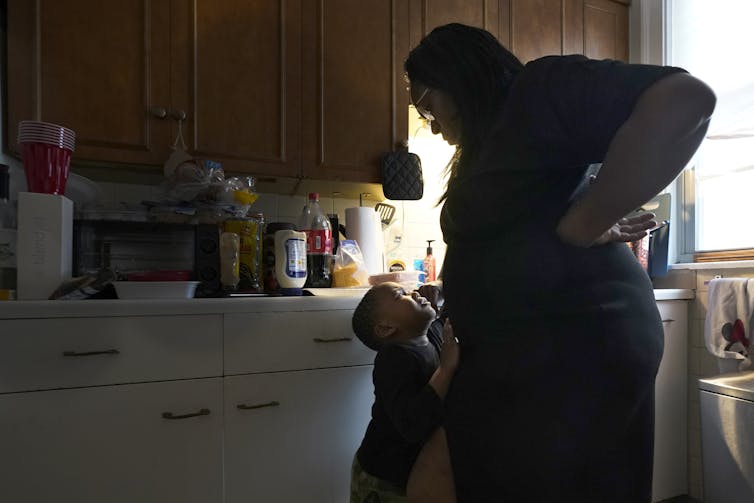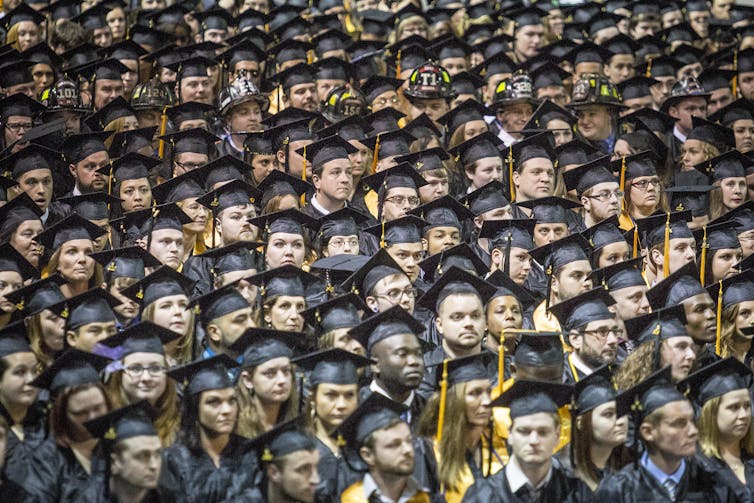Biden gives Congress his vision to 'win the 21st century' – scholars react
Three scholars examine President Biden's rhetoric, the symbolism and the several ambitious plans he proposed in his first address to Congress.

President Joe Biden spoke to Congress April 28, 2021, with a historic duo flanking him: two women, one of them African American. Vice President Kamala Harris called the proceedings to order; Speaker of the House Nancy Pelosi made the formal introduction of Biden to Congress. We asked three scholars to provide reactions to Biden’s speech, which began with a recounting of his administration’s accomplishments during its first 100 days and ended with his plea for unity so that America can “deliver on its promise.”
A return to normalcy
Karrin Vasby Anderson, Professor of Communication Studies, Colorado State University
The visual backdrop to Biden’s address to Congress highlighted what was unusual and extraordinary this year, from the masks and social distancing that signaled the continuation of the pandemic, to the two women flanking the president.
“Madam Speaker, Madam Vice President. No president has ever said those words from this podium … and it’s about time,” he said.
The rest of his address was designed to further return a sense of normalcy to presidential communication that was often absent from Donald Trump’s freewheeling – and sometimes rambling and abusive – rhetorical approach.
Communication scholars Karlyn Kohrs Campbell and Kathleen Hall Jamieson explain that presidents’ annual addresses to Congress usually do three things: promote values; assess issues; and propose policy.
Biden promoted familiar values of American optimism, success and exceptionalism. He assessed a long list of issues facing Americans, from the pandemic to jobs, the environment and to foreign policy. And he proposed a slate of policies arguably more ambitious than anything promoted from the presidential platform since Lyndon B. Johnson stumped for “The Great Society.”
Using antithesis – where two opposites are used for contrast – to draw a distinction between himself and his predecessor, Biden urged that America “is rising, choosing hope over fear, truth over lies, and light over darkness.” He also peppered his speech with alliteration, heralding “100 days of rescue and renewal,” after emerging from an “abyss of insurrection and autocracy, pandemic and pain.”
Biden explicitly invoked a famous presidential address: Franklin Delano Roosevelt’s “Arsenal of Democracy,” in which FDR tried to coax a reluctant nation to care about Adolf Hitler’s march across Europe. For Biden, the COVID-19 vaccines are part of America’s 21st-century arsenal enabling a peaceful return to international dominance.
In fact, many of the policies of care outlined in Biden’s speech were couched in the language of competition. He noted that Chinese President Xi Jinping was “deadly earnest” about China becoming “the most significant and consequential nation in the world,” and he urged that for the U.S. “to win that competition for the future,” a “once-in-a-generation investment in our families and our children” is needed.
The language of international competition is particularly well tuned to American ears. Even most of the Republicans in the audience rose to their feet when Biden concluded with the refrain that “it has never, ever, ever been a good bet to bet against America.”

More money for Pell Grants, HBCUs and Tribal Colleges
Ivory A. Toldson, Professor of Counseling Psychology, Howard University
Biden mentioned historically Black colleges and universities, also known as HBCUs, as well as tribal colleges and other minority serving institutions, signaling that they are a significant part of his agenda. These colleges and universities have been shown to improve outcomes for students who have been traditionally underrepresented in higher education.
Biden also mentioned increasing Pell Grants. President Obama used a similar strategy when striving to provide funding to institutions of higher education that serve underrepresented students. Although most students at HBCUs are eligible for the Pell grant, Pell grants can be used at any institution of higher education. For this reason, some leaders of minority serving institutions consider it disingenuous to see increases in Pell grants as a unique benefit to minority serving institutions.
Biden’s spirit and tone suggested that he considered himself to be a champion of institutions of higher education that serve low-income and historically underrepresented students. He noted that these institutions have smaller endowments but nevertheless have talented students. He also noted his wife’s affiliation with a community college. The Biden and Harris ticket is the first Democratic ticket since 1984 without an Ivy League grad.
Before the speech, President Biden released his budget proposal. The proposal calls for US$109 billion for two years of free community college and $39 billion to cover the cost of tuition for students at HBCUs, tribal colleges and universities and other minority-serving institution. This is similar to President Obama’s 2015 budget proposal. Universal higher education is necessary to achieve educational equity in the United States, so this is a proposal that I hope will gain traction.

Restoring the American dream
Veronika Dolar, Assistant Professor of Economics, SUNY Old Westbury
The U.S. has long prided itself on providing opportunities that help Americans climb the economic ladder and earn higher incomes than their parents. Some call it the “American dream,” but to economists like me, it’s known as upward social mobility.
Social mobility in the U.S. has been slipping for decades. While the vast majority of Americans born in the 1950s and 1960s earned more than their parents did, barely half of millennials can say the same – the first generation in U.S. history for whom that’s true.
Biden’s $1.8 trillion American Families Plan aims to reverse that, primarily by making what he called in his speech a “once-in-a-generation investment in our families and our children.”
One big part of that is $200 billion for universal preschool for all 3- and 4-year-olds. Research shows that childhood programs targeting disadvantaged families have substantial beneficial impacts on children’s health, future wages and education levels. This not only makes them more socially mobile but also boosts the broader economy.
[Over 100,000 readers rely on The Conversation’s newsletter to understand the world. Sign up today.]
Biden also wants to spend $225 billion to provide workers 12 weeks of paid family and medical leave.
The U.S. remains one of only a few countries without any national paid family leave policy. Just 17% of U.S. private-sector workers have access to paid family leave through their employers, and it’s even less for low-income workers.
There are myriad health and other benefits for children whose parents receive paid family leave, primarily stemming from the increased regularity of baby checkups, higher immunization rates and more years of school. A study found that after Norway introduced four months of mandatory paid leave, high school graduation and college attendance rates climbed, and children’s future earnings increased. Gains were greatest for children with less educated mothers.
The plan also includes $225 billion for more affordable child care, which studies show can improve children’s health and increases the labor force participation and employment rates of low-income mothers.
The price tag is high, and it will take time to see a return. But numerous studies have shown these types of investments are the best way to promote long-term economic growth and social mobility.
Ivory A. Toldson was affiliated with the White House Initiative on HBCUs under President Obama.
Karrin Vasby Anderson and Veronika Dolar do not work for, consult, own shares in or receive funding from any company or organisation that would benefit from this article, and have disclosed no relevant affiliations beyond their academic appointment.
Read These Next
As DOJ begins to release Epstein files, his many victims deserve more attention than the powerful me
Powerful men connected to Jeffrey Epstein are named, dissected and speculated about. The survivors,…
How to reduce gift-giving stress with your kids – a child psychologist’s tips for making magic and a
Depending on family circumstances and a child’s personality type, gift giving runs the gamut of fun…
Medieval peasants probably enjoyed their holiday festivities more than you do
The Middle Ages weren’t as dreary and desperate as you’d think, and peasants often had weeks of…





